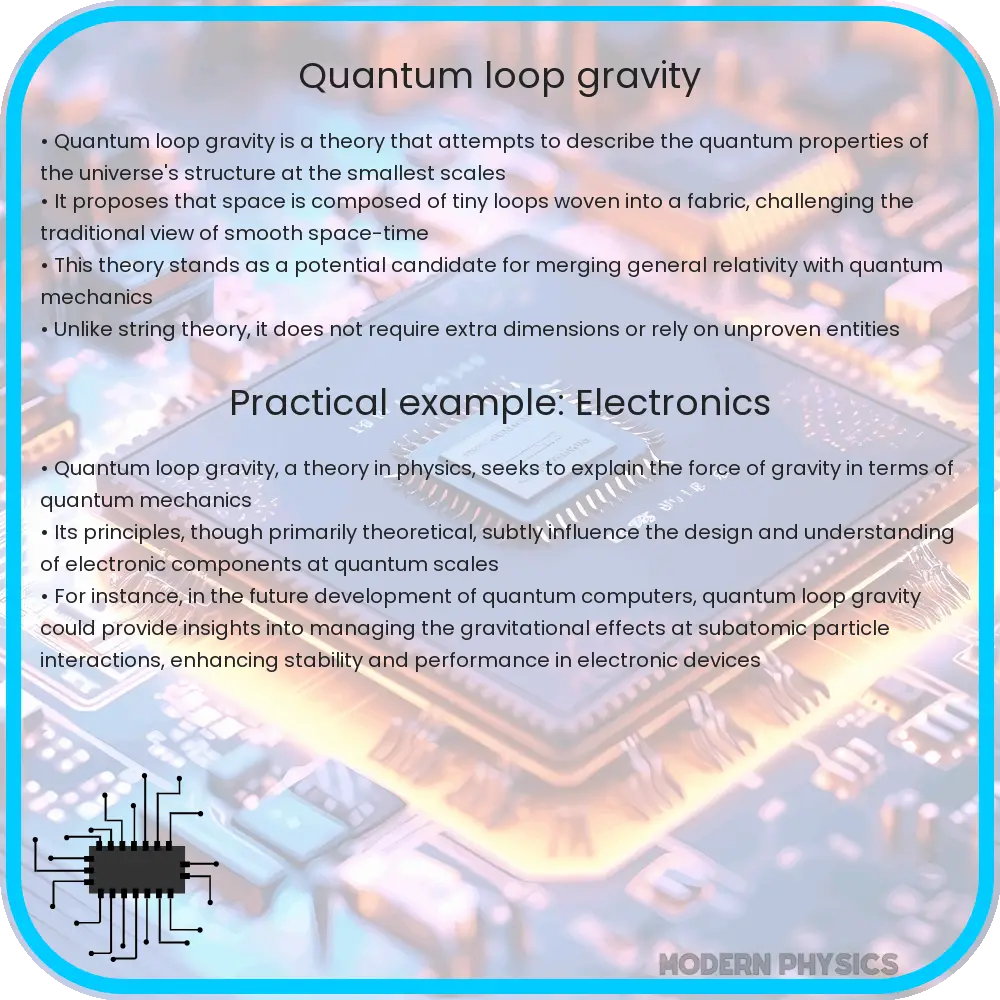Explore Quantum Loop Gravity’s insights on space-time quantization, challenges in physics unification, and its future in theoretical research.

Quantum Loop Gravity: A New Perspective on the Fabric of Space-Time
Quantum Loop Gravity (QLG) stands as one of the most promising and intriguing theories in the realm of theoretical physics. This theory aims to bridge the gap between two pillars of modern physics: General Relativity, which describes the macroscopic world, and Quantum Mechanics, which explains the microscopic phenomena. At the heart of QLG is the concept of quantizing space-time itself, a groundbreaking approach differing significantly from the more well-known string theory.
Core Insights of Quantum Loop Gravity
QLG offers a unique perspective on the fabric of the universe. Unlike the smooth, continuous space-time depicted in General Relativity, QLG suggests that space-time is composed of discrete loops, woven into a fabric. These loops are incredibly tiny, on the order of the Planck length (approximately 1.6 x 10-35 meters). This quantization implies that space-time has a ‘grainy’ texture at the smallest scales, a radical departure from our conventional understanding.
Addressing the Singularities
A significant challenge in modern physics is the occurrence of singularities, points where physical quantities become infinite, as seen in black holes and the Big Bang. General Relativity, while successful in many aspects, breaks down at these singularities. QLG offers a potential solution by quantizing space-time. In this framework, the infinities associated with singularities could be naturally resolved, leading to a more comprehensive understanding of the universe’s origins and the nature of black holes.
QLG and the Unification of Forces
The unification of all fundamental forces, including gravity, is a long-standing goal in physics. Quantum Loop Gravity makes strides towards this unification by integrating gravity into the quantum framework. It attempts to describe gravity not as a force caused by the curvature of space-time, as in General Relativity, but as a result of changes in the quantum states of these fundamental loops of space-time.
Despite its promise, QLG faces its own set of challenges. A significant hurdle is the lack of experimental evidence. The scales at which QLG operates are so minuscule that current technology is not yet capable of directly testing its predictions. Additionally, the mathematical complexity of the theory presents substantial difficulties in deriving testable predictions that could be compared with empirical data.
In conclusion, while Quantum Loop Gravity presents an innovative approach to understanding the universe, it remains a theory in development, with many questions yet to be answered.
Emerging Challenges and Theoretical Complexities
One of the central challenges in advancing Quantum Loop Gravity (QLG) is its mathematical intricacy. The theory requires a deep understanding of complex mathematical structures like knot theory and non-commutative geometry. These complexities make it difficult not only to formulate predictions but also to find consensus among physicists about the theory’s implications and correctness. The absence of a unified framework within QLG, similar to the Standard Model in particle physics, is a significant hurdle in its development.
Integrating with Other Theoretical Models
Another focus in the field of QLG is its integration with other theoretical models. Efforts are ongoing to reconcile QLG with the Standard Model of particle physics. This integration is crucial for a comprehensive theory that can describe all known fundamental forces and particles under a single framework. Additionally, the interplay between QLG and other quantum gravity theories, such as string theory, is an area of active research. Understanding the connections and distinctions between these theories may provide deeper insights into the fundamental nature of the universe.
Future Directions and Experimental Prospects
Looking forward, the path to validating or refuting QLG lies in experimental advancements. As technology progresses, experiments such as those involving high-energy particle collisions or astronomical observations at extremely small scales may offer indirect evidence supporting or contradicting the predictions of QLG. Furthermore, advancements in quantum computing and simulations could provide new ways to explore the implications of QLG, allowing physicists to test scenarios that are currently beyond the reach of experimental physics.
In the digital age, QLG also benefits from increased collaboration and information sharing among physicists worldwide. This global network accelerates the development of the theory and helps in addressing its challenges more efficiently. The internet has become a pivotal tool in fostering discussions, sharing research, and disseminating knowledge about this cutting-edge field of physics.
Conclusion
Quantum Loop Gravity represents a bold step in our quest to understand the fundamental nature of the universe. While it offers promising solutions to longstanding problems in physics, such as the nature of singularities and the unification of forces, it is still very much a theory under construction. The challenges it faces, both theoretical and experimental, are significant, but they also drive the field towards new discoveries and deeper understandings. As the theory evolves and technology advances, QLG could potentially unlock secrets of the cosmos that have puzzled scientists for decades, offering a new paradigm in our understanding of the universe.
